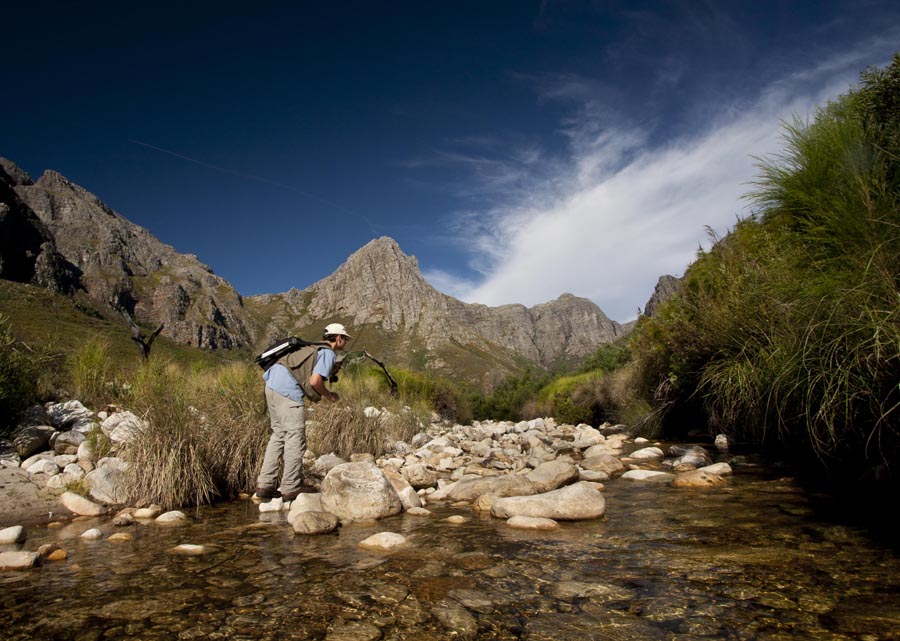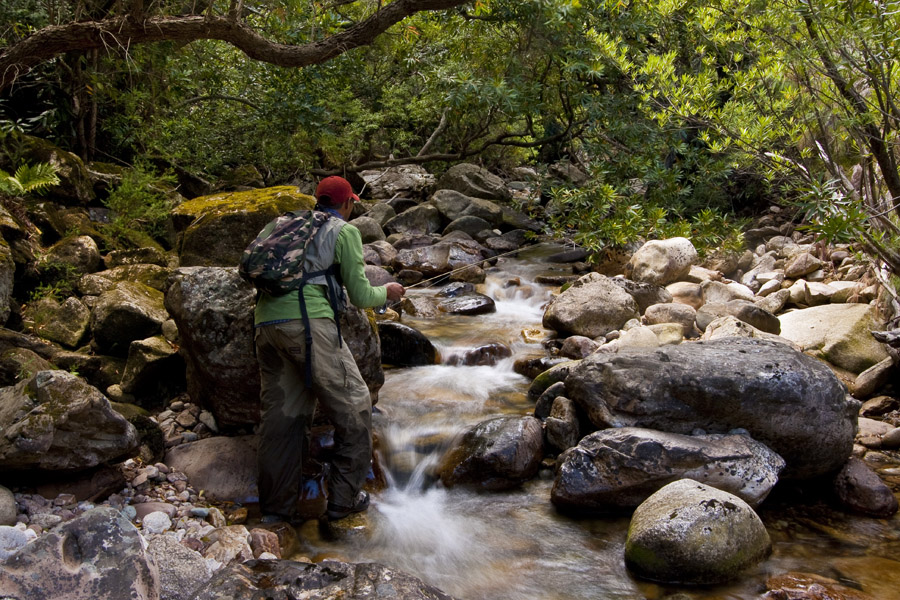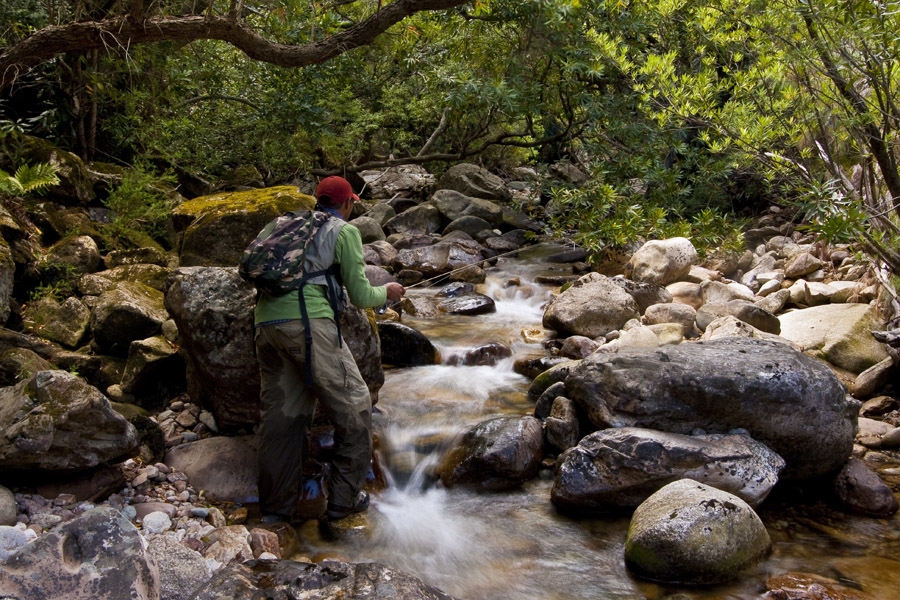Says Stanton:
Last week Thursday, wanting to capitalize on the fact that I was still on holiday, I decided to take a drive to a stream I’ve been wanting to fish for a while, the lower Wemmers at La Ferme. Upon arrival at the Wemmers I made a stop at the bridge to inspect the river before I embarked on this exploratory trip. The river looked low, but with good enough flow to fish so I decided to go ahead, what else was I going to do? So I made the necessary arrangements and within a few minutes I was ankle deep in a run on a stream I had not fished before.
Click in images to enlarge them

The Wemmers. Stanton Hector photo.
The stream was cool to the touch, which was promising. I got my casting eye in and made a cast to the first likely looking run, but to no avail. And on this trend my morning continued. I thoroughly prospected and inspected every likely looking run in about a kilometer of fishing water and found no sign of fish. It was an exploratory trip after all but seeing a trout would have made the effort worth it. Despite the absence of fish the valley looks lovely and the river holds promise to be a good fishery. After 2 hours of exploring I decided to give up.
As I made my way downstream I started thinking what was missing from the Wemmers that could influence the presence or absence of trout. Firstly, in the slower sections the river is dominated by algal blooms, a telltale sign of nutrient enrichment possibly due to the river running through fruit orchards and vineyards being sprayed with pesticides. In places the river is also badly silted. Secondly, another factor is the absence of deep pools or runs in the course of the river which are needed by trout to escape the heat of summer. The deepest pool I found was knee deep. I don’t think this is absolutely critical, because I have seen skinnier Western Cape streams with a decent head of trout and all they need is adequate streamside vegetation for shade of which the Wemmers has plenty. Thirdly, the most disturbing is the almost complete absence of aquatic insect life, possibly also a result of the presence of pesticides. I surveyed approximately ten rocks (superficial and submerged in the riverbed) in a specific area I found a few caddis larvae, a dragon fly nymph and one mayfly nymph.
Given my disappointment I decided to concentrate my efforts elsewhere and decided to head to another nearby stream that I figured should at least produce a trout or two and should take away the sting of fishless day. I have fished this particular stream frequently over the past 8 years, but have known about its trout since my childhood. This stream is affectionately known amongst the Western Cape faithful as the Little Dwars.

The Little Dwars. Tom Sutcliffe photo.
I arrived around midday, the sun was already beating down by this time, but I decided to fish anyway. The river gets as dry as a bone in summer and yet its little trout still swiftly feed in its skinny currents on any given day. I have reason to believe (and those who are familiar with the nature of the Little Dwars) would agree that it is home to probably the most hardy strain of Western Cape trout. Upon stepping into the stream I spotted my first trout in the small constructed rock pool the farm kids use as a swimming hole. I cast my fly in the skinny tail of the pool and the trout lifted smartly to my size 20 interpretation of a Quill Gordon. I tightened up and soon released the

Stanton Hector on the upper reaches of the Little Dwars. Tom Sutcliffe photo.
I headed further upstream and found another trout, which took the fly with similar conviction. With two trout in the bag I soon forgot about the Wemmers situation and proceeded upstream. I gradually noticed an absence of fish in very fishy looking runs, but proceeded anyway. While prospecting a promising run I turned around and found a troop of local kids behind me. I waved thinking that they’re just crossing the river and continued fishing soon to discover they were moving swiftly toward me. They moved quickly, rapidly passing me and headed further upstream spoiling the run I was busy fishing. In any other fishing situation this would constitute sacrilege, but had I no right to get upset because this was a stream they grew up with. I was in their backyard. It is ‘their’ stream. I decided to follow and see what they were up too. The next pool I got to I found one of the boys’ shoulder deep delving under a rock. I asked what they were looking for and the eldest one, approximately 20 years of age, replied “Fish….”. Alarm bells went off as they swiftly made their way upstream. Again I followed. Ever the scientist I relinquished my rod to take up the position of observer, making a mental note not to interfere with transpiring events. At the next pool, one of the agile youngsters managed to wiggle a trout of about

Little Dwars trout. Tom Sutcliffe photo
Devastated at the realization that this may be the end of the Little Dwars trout strain I made my way to the car. With mixed emotions I realized that ever since we (myself and a few others) started fishing this stream we have been ‘protecting’ it from by keeping it secret and here I witnessed the very trout we were ‘protecting’ being killed. Why were we keeping it secret in the first place when we should have shared its location with other likeminded souls? Surely sharing it with others is better than witnessing the killing of stream trout. However bizarre it was I realized that the kids were unaware of the significance of these trout and what they were doing was innocent. All these events got me thinking about what is currently transpiring in the South Africa as well as the Western Cape. I thought of the conditions Western Cape trout need to survive and how lucky we are to have them here in our streams. How beautiful our environs are where they are located. I thought about the shortage of available fishing waters given the current state of Cape Piscatorial Society rivers with the Holsloot out of commission, the Wemmers not living up to its potential, the pollution problems on the lower Smalblaar and the little Dwars, a technically very challenging small stream with a very important genetic resource for restocking some Western Cape angling waters, losing its trout. But mostly I thought how we should become better custodians of our freshwaters.

Stanton Hector. Tom Sutcliffe photo.



